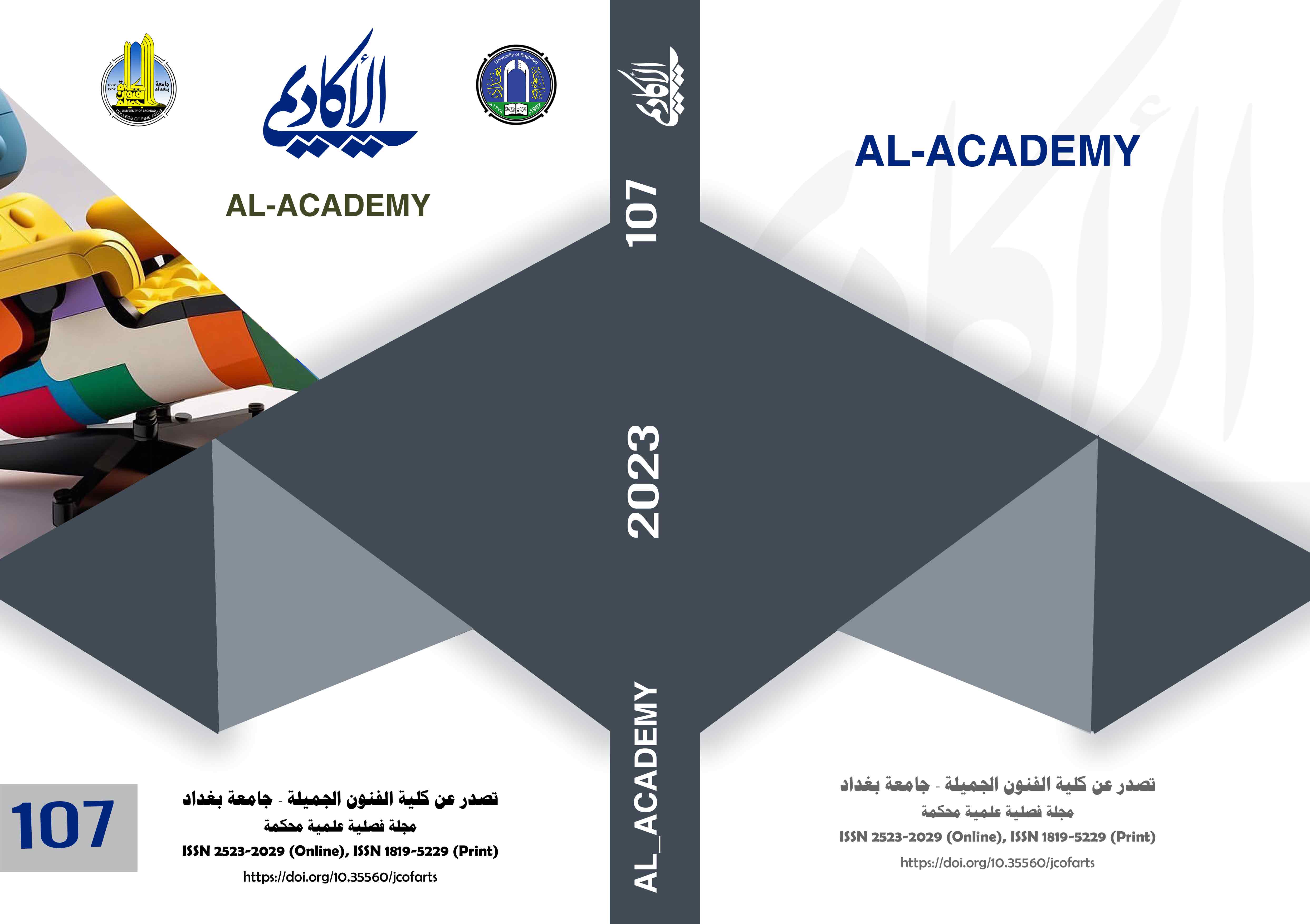الجوانب الجمالية الزخرفية واستخدامها في العمارة الاسلامية
DOI:
https://doi.org/10.35560/jcofarts107/77-92الكلمات المفتاحية:
الفن الاسلامي، الهندسة المعمارية، زخارف نباتية، الثقافة الإسلاميةالملخص
إن نشأة هذه الزخارف ومردها ومنبعها هو الإسلام والعروبة، ولم يتأثر هذا الفن بالتقاليد والعقائد التي تحكم وتطبع غيره من الفنون الأخرى في الحضارات الأخرى، فلا غرو أن نجد إِذَنْ خلوَّ هذه النقوش والزخارف الإسلامية والأشكال الهندسية عبر القرون من ذوات الأرواح من إنسان أو حيوان أو غيره من الكائنات، كما أنَّ هذه الزخارف وقفت صامدةً عبر الأزمنة المتعاقبة لا تتأثَّر بما حولها من البلدان المجاورة كالأسلوب الإغريقي مثلًا، الذي سبق هذا النموذج الإسلامي في الوجود، وهذا ما جعل الأسلوب الإسلامي يتمتع بالتفرُّد والسيادة على مرِّ العصور محافظًا على خصوصيَّته وتميُّزه، وعدم ذوبانه في الآخر.
قدمت نماذج الزخرفة عناصر مختلفة ومتعددة لم تستند إلى تصنيف استخدامها كعنصر زخرفي في مكان واحد فقط، لكنها كانت أحد أهم العناصر الزخرفية للمصمم في العصر الإسلامي القديم، والجمع بينها وبين بقية عناصر البناء المعماري، يعد التصميم الداخلي أو الأثاث أو وحدات الإضاءة أو الوحدات التكميلية سمة أساسية في العصر الإسلامي القديم، بدءاً من العلاقة المتبادلة بين الشكل المعماري الخارجي والتفاصيل الزخرفية الداخلية، وصولاً إلى تصميم الأثاث المقابل للشكل المعماري الخارجي والتفاصيل الزخرفية الداخلية، والتوافق في استخدام المواد في الهندسة المعمارية، العمارة الداخلية، وحتى العناصر المجانية والممتدة للوصول إلى استخدام وحدات الزخرفة في الكتابات والمخطوطات وكل ما مدته يد الفنان المسلم في العصور القديمة حتى وصلت إلينا في العصر الحديث. بالإضافة الي انه كيف تبنى الفنان المسلم مبدأ تحريك خياله بطريقة تمكنه من ربط القيم الجمالية للعناصر الزخرفية بأنشطته الفكرية المختلفة التي تمتد جذورها إلى أعماق الوجود البشري، وما أهميتها وما هي ؟ هل احتاج إلى منح الخيال المزيد من الفرص للتفكير في العمل الفني وقراءته؟ لدعم التأثير الواضح للعقيدة الإسلامية من حيث عدم وجود رسومات زخرفية تشمل الكائنات المتحركة وجميع الكائنات الحية، خاصة في الرسومات داخل المساجد، كيف تمكن الفنان من الخروج من أزمة تقليد أشكال المخلوقات. من الضروري العودة إلى استغلال الزخارف الإسلامية كأحد العناصر الأساسية في التصميم حتى لا يفقد المجتمع هويته ويدرك المعاني العميقة وراء الأشكال المجردة التي تعبر عن عالم جمالي خاص يتجاوز حدود الصور والأشكال ويكتسب شخصية بالابتعاد عن محاكاة الواقع من خلال تبسيط الأشكال وتجريدها كما أوصي بالاهتمام بالتجديد والابتكار، والاعتماد على التطوير المباشر دون الانتقال والابتعاد عن التقليد والاصطناعية في الأعمال الزخرفية في الهندسة المعمارية والمجالات الأخرى.
المراجع
Dorothea: Design Elements and principles, U.S.A.,1995.
Pope (A.U: Survey of Persian Art, Vol IV part II .
Saria, A. Sidky: Analysis of Dynamic Interplay Encountered in an Islamic Geometrical Art. Unit: A system perspectives Ph.D., State University, New York at Buffalo. September,1989.
Wilber Du Donald: The Architecture of Islamic Iran: The Ilkanid period – Princeton University,1955.
Ryan, M.G.; 2002: "The Complete Encyclopedia of Stitchery" Barnes & Noble Books, New York
Abas S., Salman A. (1995), Symmetries of Islamic Geometrical Patterns, World scientific publishing Co. Pte. Ltd, Singapore.
Akkach, S. (2005), Cosmology and Architecture in Pre modern Islam: An Architectural Reading of Mystical Ideas. Albany: State University of New York Press.
Baer, E. (1998), Islamic Ornament, Edinburgh University Press, Edinburgh, pp. 160.
Bonner Jay (2003),Three Traditions of Self-Similarity in fourteenth and Fifteenth Century Islamic Geometric
Ornament, Meeting Alhambra, Isama- Bridges Conference Proceedings , pp. 1-12
Brend Barbara (1991), Islamic Art, British Museum Press, Great Britain.
التنزيلات
منشور
إصدار
القسم
الرخصة
الحقوق الفكرية (c) 2023 Tahani Mohammad Nasser AL-Arifi

هذا العمل مرخص بموجب Creative Commons Attribution 4.0 International License.













